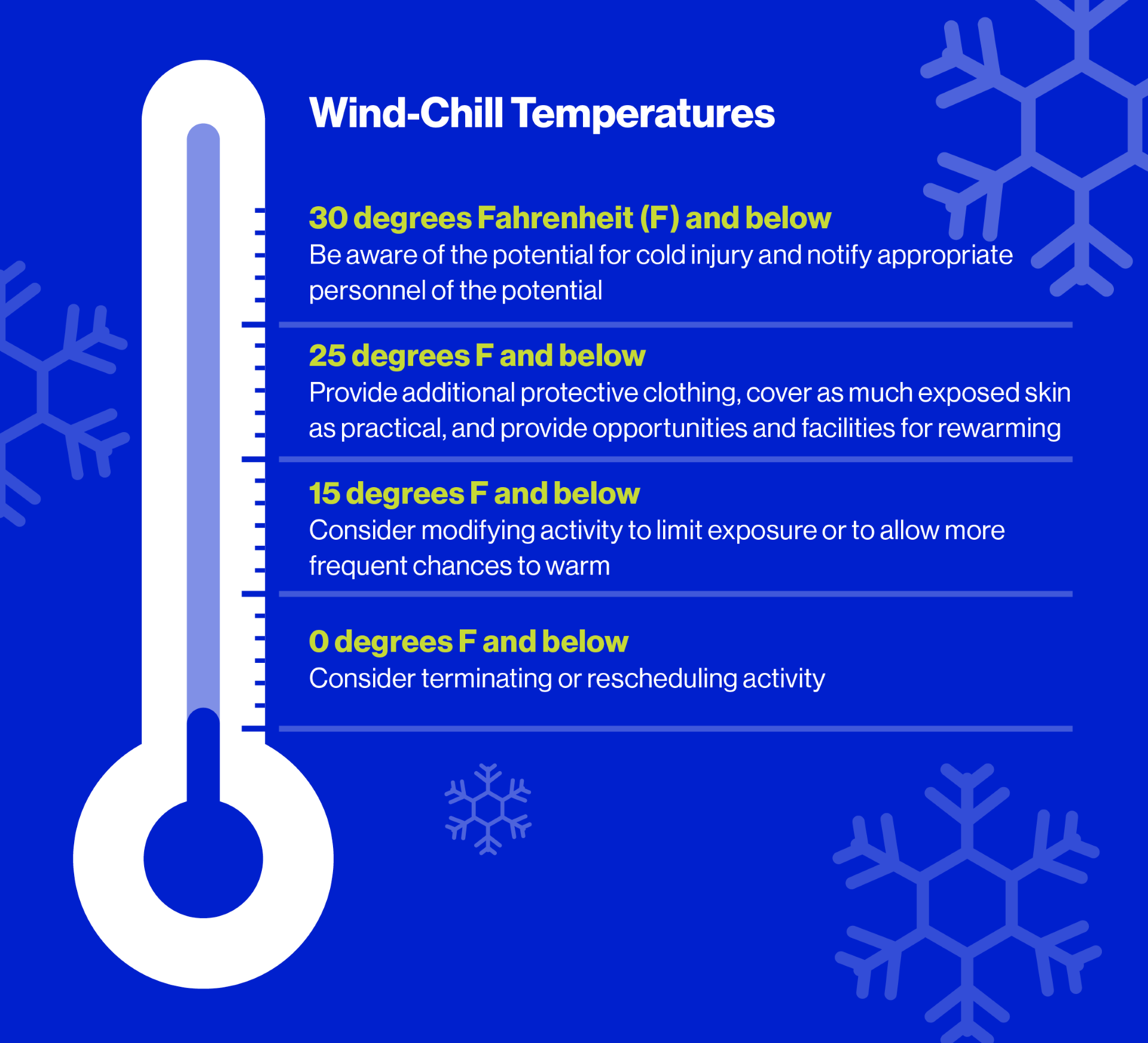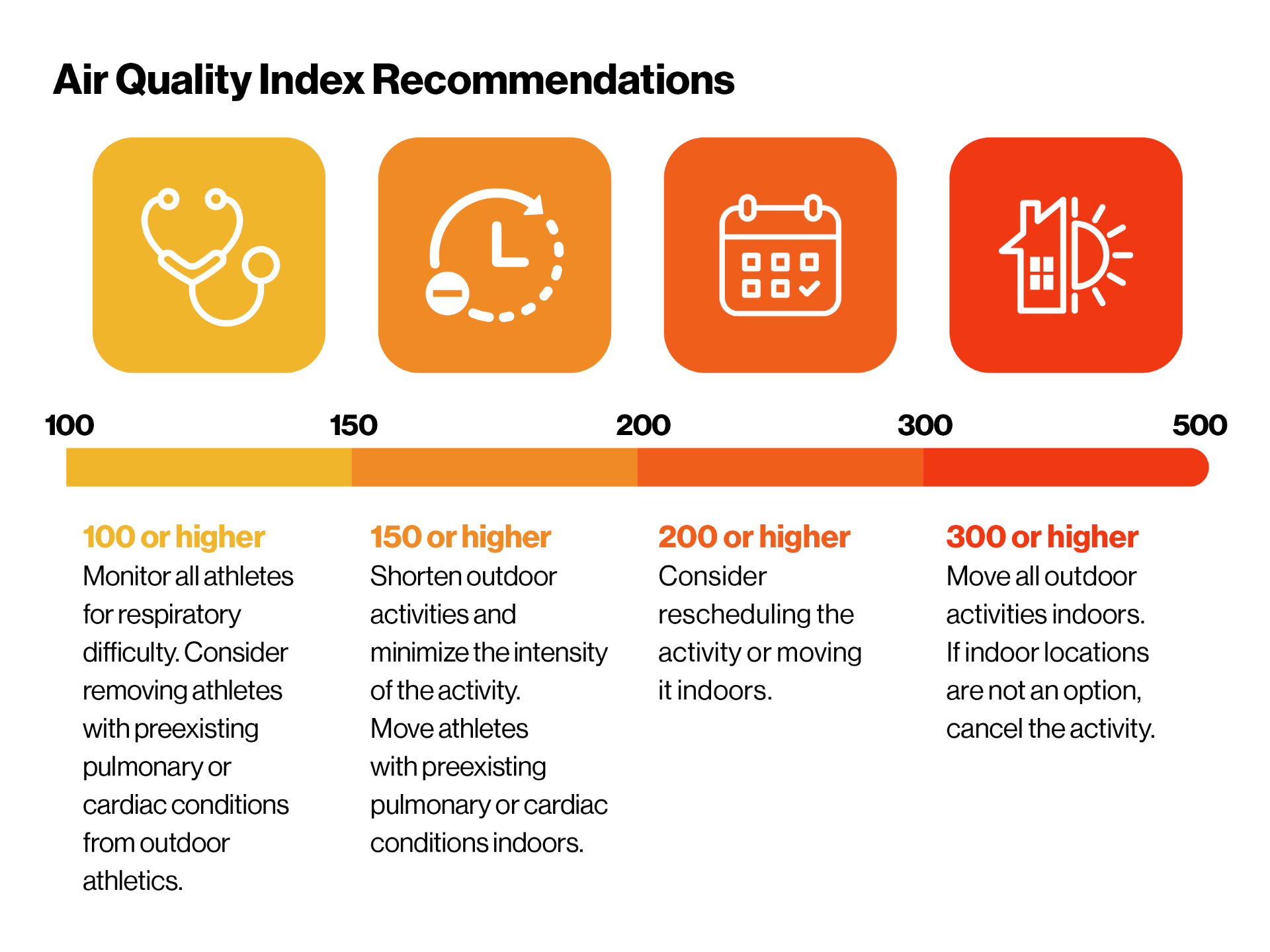Severe Weather at Outdoor Athletic Events
When severe weather hits an outdoor athletic event, it can impact athletes, coaches, staff, and the viewing crowd. As severe weather patterns become more common, it’s particularly important to prepare in advance. Staff members who oversee athletics, facilities, and risk management should work together to develop or reevaluate severe weather policies for outdoor athletic events.
Types of Weather to Monitor
Common weather events vary by region, but unusual extreme weather can occur nearly anywhere. Familiarize yourself with hazards related to all weather events.
Cold weather can induce injuries including hypothermia and frostbite. The National Athletic Trainers’ Association (NATA) recommends responses to the following wind-chill temperatures:

Extreme heat and humidity can result in heat illness for athletic participants and other attendees. Heat stress monitors detect environmental risks to players by measuring the wet-bulb globe temperature (WBGT), a measurement of heat intensity created by evaluating sun exposure, air temperature, humidity, and wind speed. Some states require high schools to take WBGT readings before athletic practice or competition.
NATA suggests taking greater caution during athletic activities if the WBGT is higher than 82° Fahrenheit:
- Consider rescheduling or delaying the event until safer conditions prevail.
- Include more and longer rest breaks.
- Reduce practice time.
- Reduce exercise intensity.
- Provide access to shade.
- Minimize heavy clothing and equipment that can cause overheating.
- Provide cold water immersion tubs on-site in case of overheating.
Use regional WBGT recommendations to reduce the number of exertional heat illnesses and monitor the WBGT at practices and competitions to determine when enhanced protective measures are necessary.
Lightning strikes can quickly cause permanent injury and even death. If lighting or thunder are observed, or a thunderstorm appears imminent, instruct participants and observers to go indoors. NATA also recommends suspending activities until 20 minutes after the last strike of lightning is seen and after the last sound of thunder is heard.
Severe rain sometimes occurs without lightning. The National Weather Service (NWS) provides potential flood indicators. Learn the terminology and take actions when appropriate.
- Flood Watch — Conditions are favorable for a specific hazardous weather event to occur. It doesn’t mean flooding will occur, but it is possible. Consider suspending activities and moving to higher ground until the watch is ended.
- Flood Advisory — A specific weather event that is forecast to occur may become a nuisance. If caution isn’t exercised, it could lead to situations that may threaten life and property. Suspend activities and move to high ground until the advisory ends.
- Flash Flood Warning/Flood Warning — Flooding is imminent or occurring. Cancel events. Move everyone to high ground.
Heavy wind also can cause unexpected injuries. Watch for NWS alerts about potential wind events.
- High Wind Watch — Sustained, strong winds are possible. Consider postponing activities and seeking shelter until the alerts are cleared.
- Wind Advisory — Strong winds are occurring but are not so strong as to warrant a High Wind Warning. Consider postponing any activities and seeking shelter until the alerts are cleared.
- High Wind Warning — Sustained, strong winds with even stronger gusts are happening. Take temporary shelter until the alert is cleared.
Air quality issues caused by pollutants can create increased risk of injury for athletes, especially because they often inhale deeper due to exercising. The NWS’ Air Quality Forecast System provides a real-time Air Quality Index (AQI). The NCAA recommends:

- The National Federation of State High School Association’s position statement on air quality notes that activities moved indoors due to air quality should ensure the HVAC system properly filters indoor air. If the HVAC system can’t properly filter pollutants, indoor air quality may be worse than outdoor.
Create a Formal Process for Responding to Severe Weather Events
The NATA Lightning Safety Position Statement provides prevention guidance relevant to creating or revising a severe weather policy. Your policy should include these elements:
- Weather monitoring. Organizers of outdoor athletic events should monitor the local weather forecast before the event and know their local weather patterns. Local weather forecasts are available from the NWS at www.weather.gov. You also can view current alerts at https://alerts.weather.gov/. You can find your local forecasts on the NWS Weather Forecast Offices map. This map shows the regional headquarters. When possible, assign someone in the Athletic, Facilities, or Risk Management departments to create a working relationship with your local NWS office to help identify local weather patterns and how best to use their resources.
- Chain of command. Identify the people or roles responsible for monitoring the weather and who have the authority to postpone, cancel, or remove participants from athletic venues or activities. Ensure sports medicine staff are always authorized to cancel events for health and safety reasons.
- Safe locations. State that in the event of sudden severe weather, athletic participants and spectators should go to a safe location, such as a nearby building. Ensure someone provides guidance on getting there and does not allow athletes or spectators to linger. Have a plan in place for each of your athletic locations.
- Criteria to suspend and resume activities. Create a team to develop your severe weather at athletic events policy. Include people assigned to monitor weather, athletic trainers, athletics administrators, and anyone else in the weather determination chain of command. Use the guidelines in the Types of Weather to Monitor section above and information from your local weather offices to develop policies for severe weather events. Any current severe weather should result in the suspension or cancelation of events.
- Crisis response. When weather-related injuries occur, refer to the facility’s emergency action plan (EAP) for step-by-step response instructions.
Protect Coaches, Staff, and Attendees
When severe weather strikes, it’s important that everyone at the game is protected. If the weather is severe enough that athletes are brought to a safe location inside, the same should be true for anyone else at the event. Assign someone in advance to take charge of the gathered crowd and make announcements — this may be an announcer or a coach. Periodically review your intended safe locations to ensure they can shelter the number of people that attend athletic events.
For severe weather that doesn’t require relocation, consider implementing similar protective procedures for staff and attendees that you do for athletes. For example, on hot and humid days, provide coolers with ice water.
More From UE
Assess Climate Impact on Campus
Crisis Response: A Library of Tabletop Exercises
Additional Resources
NCAA: Inclement/Hazardous Weather
NATA Position Statement: Lightning Safety for Athletics and Recreation
Policies
About the Author
-

Melanie Bennett, Esq., ARM-E
Senior Risk Management Counsel
In her role on UE’s Risk Research team, Melanie dives into timely topics affecting education. Her areas of expertise include protecting minors, enterprise risk management (ERM), technology accessibility, and athletics. Prior to joining UE, she interned at the U.S. Department of Education’s Office for Civil Rights. Melanie serves on the Higher Education Protection Network’s (HEPNet’s) Board of Directors.